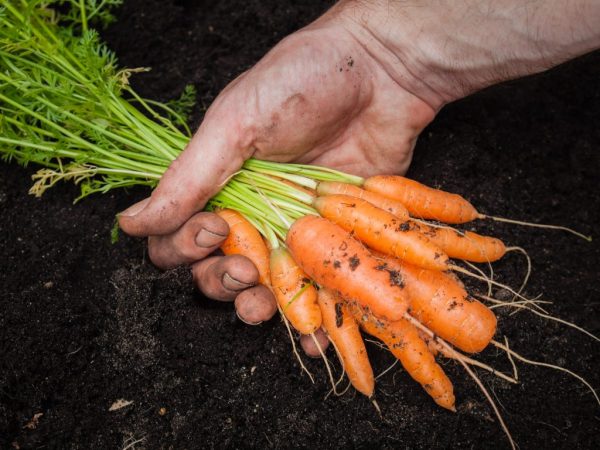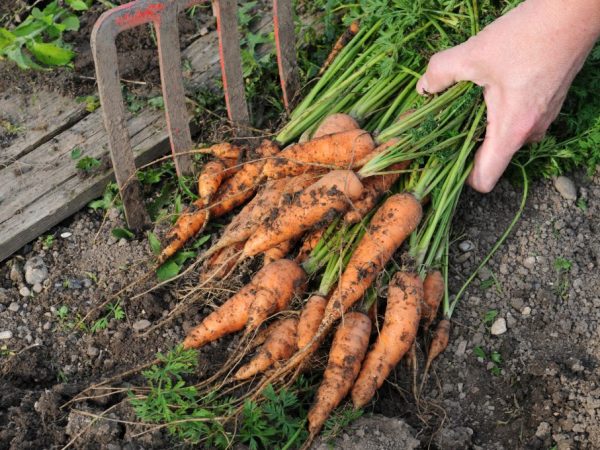Harvesting carrots according to the lunar calendar
In late summer and early autumn, it is time to harvest. Root crops are especially important for a temperate climate. To preserve Yields, it is important when and how to remove carrots from the beds, as well as how to harvest the beets so as not to damage the roots. In addition to assembly technology, numbers according to the lunar calendar play an important role.

Harvesting carrots according to the lunar calendar
Harvesting technology
During the digging, the rules of harvesting are observed. This helps to get undamaged and long-term perishable fruits. They are stored in cellars or basements (for the winter) or at home (for a short period). Once properly dug up, the fruit requires less preparation for storage.
General rules for harvesting root crops
These crops are of the same type, therefore it is recommended to dig up beets and carrots, adhering to the rules for cleaning from the garden:
- It is necessary to harvest carrots and beets within the time limits indicated on the package with seeds. Early extraction will result in unripe fruit, due to late harvest the fruit will start to deteriorate in the ground.
- Both root crops are harvested in dry weather, because before storage they are cleaned of soil residues and dried.
- Digging carrots is not advised to carry out with a shovel. It damages the vegetable and shortens its shelf life. Use a blunt pitchfork or digging.
Also, carrots are harvested with home-made combines. Such a machine is capable of harvesting up to 30 hectares of land.
Harvesting according to the lunar calendar
The crop is often harvested following the lunar calendar. This is an additional method for improving the quality of the fruit.
The influence of the moon on cultures
The influence of the heavenly body on a person and everything that surrounds him was noticed by the ancestors. Nowadays, many people use the lunar calendar for planting and harvesting crops. It says in what phases the moon is on certain days of the month.
Dates in 2018 September-October
It is advised to dig up beets and carrots during the waning moon. During this lunar cycle, the movement of juices in fruits slows down, growth stops, and the time is right for harvesting crops from the beds. In 2018, in September-October, the waning moon will be:
- September 1-8;
- September 26-30;
- October 1;
- October 3-8;
- October 25-30.
It is not recommended to dig up beets or carrots during the growing moon and full moon, since at this time there is an active movement of juices inside the fruits, a phase of active growth.
For root crops, the movement of juices is important, because the juiciness and richness of the fruit determine the desired structure and taste. When dug up in a suitable cycle, beets and carrots are easier to store for storage. In addition, they have a long shelf life.
Failure to comply with calendar rules
Regardless of the lunar calendar, the garden is cleaned in case of overripe fruits, the threat of frost and suitable dates.
Plus, it's hard to sync your schedule with the moon's calendar.In this case, it can be disregarded, but at the same time carefully care for the crops as they require it. The help of the moon is just an additional tool that helps to get a better harvest.
Features of picking carrots

Carrots should be harvested by hand
For this root crop, it is necessary to determine the degree of ripeness of the fruits and correctly remove them from the garden to increase keeping quality. Equally important for the fruit is the observance of the timing of the carrot harvest. They depend on:
- Root varieties. Depending on this, the vegetable is harvested 90 to 130 days after planting.
- Weather conditions. Hot, humid summers accelerate ripening, at the same time the fruits are harvested before the first frost.
- Soil features, crop care. With proper watering and feeding, the time is reduced.
Harvesting should be done manually. The root crop is taken by the tops and pulled out of the ground. Large fruits are dug in a little, and then removed. After harvesting, the tops are cut, leaving 1-2 mm, the dug out culture is left to dry for a while in the sun, then under a canopy.
By external signs, maturity is determined as follows:
- the leaves of the vegetable begin to turn yellow and dry;
- pull out 1 fruit and examine its size and maturity.
In the case of planting several varieties of different ripeness, they are harvested not simultaneously, but gradually. The early varieties are eaten, and the late ones are left to winter. Even in a cellar or basement, the fruit is not stored for more than 4 months.
Features of collecting beets
Determining the right time to harvest beets is more difficult. There are many more factors to consider besides the timing indicated on the package. The timing of harvesting carrots and beets should be used in different ways. When cleaning the latter, the appearance is taken into account, it is necessary that:
- The leaves of the tops turned yellow and wilted.
- The fruits have not yet hardened. If growths and white stripes appear on them, the vegetable is immediately dug up.
- Growths appeared on the fruits. This is a sure sign that it's time to harvest.
Deadlines are not met if frosts are foreseen. In the cold, the tops of the fruit freeze and the fruit becomes unusable.
General recommendations for cleaning: dig in the top layer of the earth with a pitchfork. Pull it out of the ground with your hands, knock it off the ground. The tops are cut, leaving 2 cm. They are dried in the sun.
Conclusion
Cultures are dug out, observing the technology and recommendations for collection. It is important to comply with the terms, not to harm the fruit in order to increase their keeping time.
Also use the phases of the moon. This is an optional option that is used as an additional tool when working on the site. Root crops are harvested from the garden during the waning moon, when the movement of juices stops.


